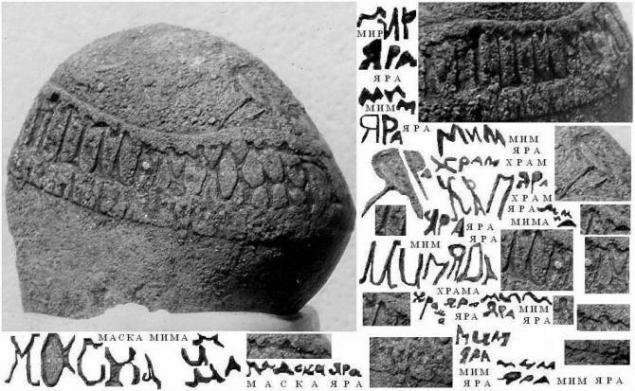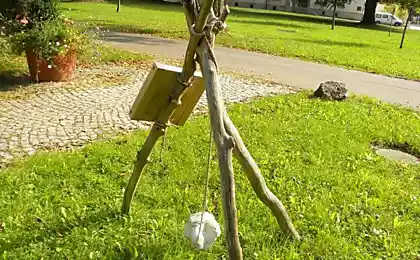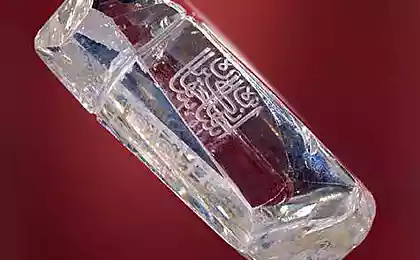297
Ancient stone with Slavic writings from... America
This mystery of history would not have existed had Jack Nelson not wanted vegetables from his garden. The mysterious artifact would continue to lie in the ground and would not disturb the minds of scientists, and would not question the course of human history. But this amazing object was still brought to light. After a short time, you will be lost forever.
In 1927, Jack Nelson took a shovel and went to dig up the land in his land, located in Minnesota. More specifically, in a small village called Rozier (or Roseau). He was digging himself and digging, when he suddenly noticed a strange pebble, which did not resemble ordinary ones, because it clearly bore traces of processing.
Jack did not lazy, picked up the find and cleared the ground. The oval stone was very small, only five centimeters in diameter. On the one hand, a kind of human face was carved on it, around which there was a tape either with a picture, or with some inscription in an unfamiliar language.

Destroyed relic
That’s not to say Jack was too surprised by his discovery. He had come across various interesting things on this site before: then shards, then ancient arrowheads, then stone hammers. This is understandable - the site was on the site of an ancient Indian settlement. However, the new stone did not resemble the previous finds. So Jack put it in his pocket and decided to show it to a specialist.
It was John Jager of Minneapolis, a famous American anthropologist and expert on ancient texts. Nelson brought Jager his find, but he couldn’t decipher the inscription and asked him to leave it to him for research. Jack agreed and thus deprived the scientist of peace for 15 years!
The stone, which at the place of finding began to be called the stone Rozier, was not at all simple! After carefully studying it, Jager came to startling conclusions. He wrote in his diary: This inscription was made before the Greek and Egyptian civilizations. It is even more ancient than the Sumerian, which is considered the first civilization on Earth in the IV-III millennia BC. And more ancient than Çatal-Hyüyuk in Anatolia, which was considered the ancestral homeland of all mankind in the V millennium BC.
Is this really the face of an ancient Russian god?
Most of all, the scientist sought to decipher the text engraved on the Rozier stone. He managed to pick out a few separate words from the tape, but he could not read them. Although he compared the inscription with ancient samples of writing collected from all over the world.
The only assumption that Jager eventually made was that some mythical “Argonauts” were the authors of the text on the stone. According to John, they spoke an ancient language that was the mother of all other future languages and dialects. Jager called it Euro-Afro-Asian. “It was spoken and written by the first people on Earth – the masters of the ocean, who sailed around the world,” the scientist concluded.
Most of Jager's colleagues with whom he shared his theory called him a fantasist. Only two scientists from the University of Minnesota were interested and decided to join the study of the Rozier stone. These were Professor of Anthropology Dr. Jenks and his colleague, Professor of Geology Dr. Stoffer. But the methods they chose were extremely unsuccessful. Scientists, having decided to clean the surface of the accumulated plaque, left the stone for some time in an acid bath. However, the acid has eaten not only dirt, but also the inscription!
Jager was very upset. Of course, the inscription was copied many times, but the unique stone itself was damaged. You can tell how the artifact was completely destroyed. But even worse, after his death in 1959, the remains of the stone, as well as all the materials about the unique artifact, disappeared.
Difficulties in translation
Perhaps the stone, lost first in the land of Minnesota, and then in the archives of the University of Minnesota, and would have disappeared if not Chris Paytnaud, engaged in the study of the ancient history of the North American continent. One day, this researcher, rummaging through the university library, accidentally came across Jager's folder. Almost mechanically, she looked into it and found there photographs of the Rozier stone, along with materials on its study.
The pictures were very clear, so the inscriptions could be seen well. Which Chris Paytnaud did. She immediately thought the inscriptions reminded her of something. She recalled that she saw very similar ones and that they were made in Russian. This struck her so much that she, having abandoned all her business, took Rozier's stone seriously.
Paitnaud immediately wrote to her Russian colleague Vladimir Pakhomov, who, although a mathematician, not a historian, could help decipher the inscription. Of course, if Chris's hunch about language was correct. “It’s a shame he disappeared,” she wrote. Today, with the help of modern technology, we could even restore the erased image.
“One look was enough for me to understand: I had a text in Russian,” Vladimir Pakhomov recalled. Here are just a few words that are easy to read if you look: Yara Lik, Lighthouse, Temple of Yara, We are from the fury of Russia.

To say that Chris Paithnaud was shocked by his response is to say nothing. It was written in Russian, but where did it come from? Who made it and why? And most importantly, how did he make it so many centuries before Cyril and Methodius?
There were a lot of questions immediately. But it became clear why Jager could not decipher the inscription. Of course, he did not even think about such a “young” language as Russian, comparing the inscription only with ancient writings.
However, even if he thought about the Russian language, he is not so easily recognized in the inscription on the stone Rozier. “For example, the ‘I’ is almost without a hind leg, it can be completed only by the imagination of a researcher who knows Russian well,” Pakhomov said.
Pagan lighthouse
The news that an ancient stone with a Russian inscription was found in America was received with great interest by many in our country. Alas, most of those interested were amateur historians or supporters of so-called alternative history.
The notorious Valery Chudinov, director of the Institute of Old Slavic and Ancient Eurasian Civilization of the public organization RAEN, immediately announced that the Rozier stone is another proof that the history of Russia began not in the time of the Scythians, but many millennia earlier. And that in those days when humanity was one people, it spoke one language - Russian. Some even believe that the Slavs could be the discoverers of the American continent.
Some researchers do not risk making such sensational conclusions and put forward other, however, no less controversial theories. That the rock could have hit Minnesota by accident. For example, it was once presented to Americans by Russian immigrants. Or it was stolen from them, and then passed from hand to hand until it settled in the Indian lands.
Another version is that the artifact was made in America by natives of Alaska. And it was used as a "beacon" - that is, a pointing stone. The question arises: what did he point to in this case?
Supporters of the theory of the “lighthouse” believe that the stone guided everyone to the sanctuary of the ancient Russian deity Yar. And the face on the stone of Rosier is, in fact, his image.
Evidence of contacts with Russians who brought with them to America their faith in a god or goddess named Yar (Yara), these researchers believe the Indian myth of the beautiful Yara, which fell in love with the owner of the rivers and lagoons – a giant snake. The spirits of the mountains saved Yara from the snake and made the goddess-guardian of nature. In the language of the Indians there is a stable expression “place of Yara”, which they denote beautiful places.
The authors of this theory believe that once they could be the temples of the Russian Yar or Yar. Official science is in no hurry to comment on these theories. And a pity, because the solution of the images on the stone of Rosier would be interesting to many people interested in history.
Perhaps historians believe that if the stone itself is lost, then there is nothing to talk about, but after all, there are evidence and documentary materials that continue to excite minds, like any unsolved mystery.
Source: paranormal-news.ru
Source: /users/1077
In 1927, Jack Nelson took a shovel and went to dig up the land in his land, located in Minnesota. More specifically, in a small village called Rozier (or Roseau). He was digging himself and digging, when he suddenly noticed a strange pebble, which did not resemble ordinary ones, because it clearly bore traces of processing.
Jack did not lazy, picked up the find and cleared the ground. The oval stone was very small, only five centimeters in diameter. On the one hand, a kind of human face was carved on it, around which there was a tape either with a picture, or with some inscription in an unfamiliar language.

Destroyed relic
That’s not to say Jack was too surprised by his discovery. He had come across various interesting things on this site before: then shards, then ancient arrowheads, then stone hammers. This is understandable - the site was on the site of an ancient Indian settlement. However, the new stone did not resemble the previous finds. So Jack put it in his pocket and decided to show it to a specialist.
It was John Jager of Minneapolis, a famous American anthropologist and expert on ancient texts. Nelson brought Jager his find, but he couldn’t decipher the inscription and asked him to leave it to him for research. Jack agreed and thus deprived the scientist of peace for 15 years!
The stone, which at the place of finding began to be called the stone Rozier, was not at all simple! After carefully studying it, Jager came to startling conclusions. He wrote in his diary: This inscription was made before the Greek and Egyptian civilizations. It is even more ancient than the Sumerian, which is considered the first civilization on Earth in the IV-III millennia BC. And more ancient than Çatal-Hyüyuk in Anatolia, which was considered the ancestral homeland of all mankind in the V millennium BC.
Is this really the face of an ancient Russian god?
Most of all, the scientist sought to decipher the text engraved on the Rozier stone. He managed to pick out a few separate words from the tape, but he could not read them. Although he compared the inscription with ancient samples of writing collected from all over the world.
The only assumption that Jager eventually made was that some mythical “Argonauts” were the authors of the text on the stone. According to John, they spoke an ancient language that was the mother of all other future languages and dialects. Jager called it Euro-Afro-Asian. “It was spoken and written by the first people on Earth – the masters of the ocean, who sailed around the world,” the scientist concluded.
Most of Jager's colleagues with whom he shared his theory called him a fantasist. Only two scientists from the University of Minnesota were interested and decided to join the study of the Rozier stone. These were Professor of Anthropology Dr. Jenks and his colleague, Professor of Geology Dr. Stoffer. But the methods they chose were extremely unsuccessful. Scientists, having decided to clean the surface of the accumulated plaque, left the stone for some time in an acid bath. However, the acid has eaten not only dirt, but also the inscription!
Jager was very upset. Of course, the inscription was copied many times, but the unique stone itself was damaged. You can tell how the artifact was completely destroyed. But even worse, after his death in 1959, the remains of the stone, as well as all the materials about the unique artifact, disappeared.
Difficulties in translation
Perhaps the stone, lost first in the land of Minnesota, and then in the archives of the University of Minnesota, and would have disappeared if not Chris Paytnaud, engaged in the study of the ancient history of the North American continent. One day, this researcher, rummaging through the university library, accidentally came across Jager's folder. Almost mechanically, she looked into it and found there photographs of the Rozier stone, along with materials on its study.
The pictures were very clear, so the inscriptions could be seen well. Which Chris Paytnaud did. She immediately thought the inscriptions reminded her of something. She recalled that she saw very similar ones and that they were made in Russian. This struck her so much that she, having abandoned all her business, took Rozier's stone seriously.
Paitnaud immediately wrote to her Russian colleague Vladimir Pakhomov, who, although a mathematician, not a historian, could help decipher the inscription. Of course, if Chris's hunch about language was correct. “It’s a shame he disappeared,” she wrote. Today, with the help of modern technology, we could even restore the erased image.
“One look was enough for me to understand: I had a text in Russian,” Vladimir Pakhomov recalled. Here are just a few words that are easy to read if you look: Yara Lik, Lighthouse, Temple of Yara, We are from the fury of Russia.

To say that Chris Paithnaud was shocked by his response is to say nothing. It was written in Russian, but where did it come from? Who made it and why? And most importantly, how did he make it so many centuries before Cyril and Methodius?
There were a lot of questions immediately. But it became clear why Jager could not decipher the inscription. Of course, he did not even think about such a “young” language as Russian, comparing the inscription only with ancient writings.
However, even if he thought about the Russian language, he is not so easily recognized in the inscription on the stone Rozier. “For example, the ‘I’ is almost without a hind leg, it can be completed only by the imagination of a researcher who knows Russian well,” Pakhomov said.
Pagan lighthouse
The news that an ancient stone with a Russian inscription was found in America was received with great interest by many in our country. Alas, most of those interested were amateur historians or supporters of so-called alternative history.
The notorious Valery Chudinov, director of the Institute of Old Slavic and Ancient Eurasian Civilization of the public organization RAEN, immediately announced that the Rozier stone is another proof that the history of Russia began not in the time of the Scythians, but many millennia earlier. And that in those days when humanity was one people, it spoke one language - Russian. Some even believe that the Slavs could be the discoverers of the American continent.
Some researchers do not risk making such sensational conclusions and put forward other, however, no less controversial theories. That the rock could have hit Minnesota by accident. For example, it was once presented to Americans by Russian immigrants. Or it was stolen from them, and then passed from hand to hand until it settled in the Indian lands.
Another version is that the artifact was made in America by natives of Alaska. And it was used as a "beacon" - that is, a pointing stone. The question arises: what did he point to in this case?
Supporters of the theory of the “lighthouse” believe that the stone guided everyone to the sanctuary of the ancient Russian deity Yar. And the face on the stone of Rosier is, in fact, his image.
Evidence of contacts with Russians who brought with them to America their faith in a god or goddess named Yar (Yara), these researchers believe the Indian myth of the beautiful Yara, which fell in love with the owner of the rivers and lagoons – a giant snake. The spirits of the mountains saved Yara from the snake and made the goddess-guardian of nature. In the language of the Indians there is a stable expression “place of Yara”, which they denote beautiful places.
The authors of this theory believe that once they could be the temples of the Russian Yar or Yar. Official science is in no hurry to comment on these theories. And a pity, because the solution of the images on the stone of Rosier would be interesting to many people interested in history.
Perhaps historians believe that if the stone itself is lost, then there is nothing to talk about, but after all, there are evidence and documentary materials that continue to excite minds, like any unsolved mystery.
Source: paranormal-news.ru
Source: /users/1077























